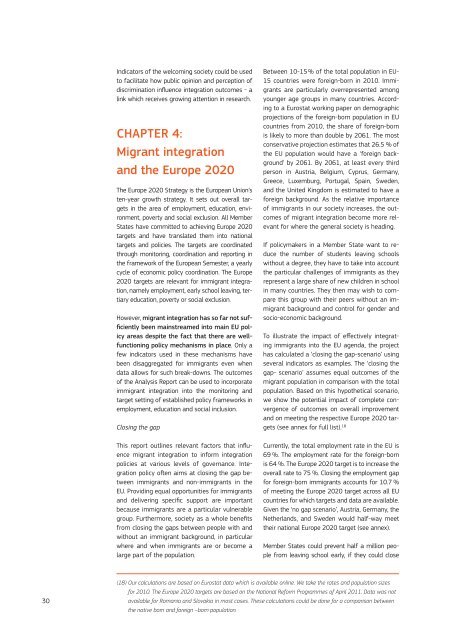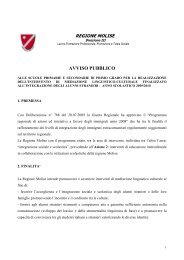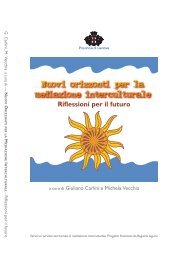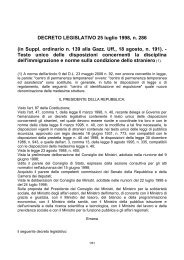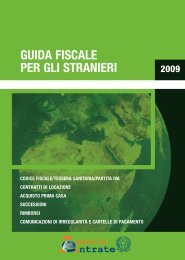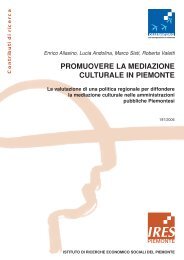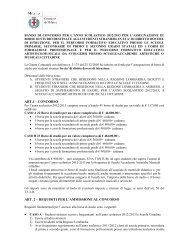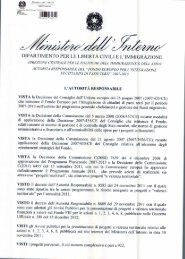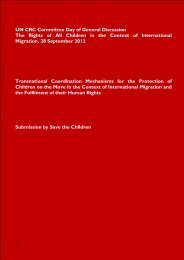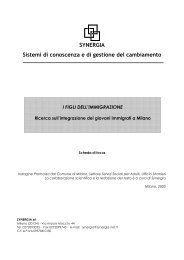Using EU Indicators of Immigrant Integration - European ...
Using EU Indicators of Immigrant Integration - European ...
Using EU Indicators of Immigrant Integration - European ...
- No tags were found...
Create successful ePaper yourself
Turn your PDF publications into a flip-book with our unique Google optimized e-Paper software.
<strong>Indicators</strong> <strong>of</strong> the welcoming society could be usedto facilitate how public opinion and perception <strong>of</strong>discrimination influence integration outcomes - alink which receives growing attention in research.Chapter 4:Migrant integrationand the Europe 2020The Europe 2020 Strategy is the <strong>European</strong> Union’sten-year growth strategy. It sets out overall targetsin the area <strong>of</strong> employment, education, environment,poverty and social exclusion. All MemberStates have committed to achieving Europe 2020targets and have translated them into nationaltargets and policies. The targets are coordinatedthrough monitoring, coordination and reporting inthe framework <strong>of</strong> the <strong>European</strong> Semester, a yearlycycle <strong>of</strong> economic policy coordination. The Europe2020 targets are relevant for immigrant integration,namely employment, early school leaving, tertiaryeducation, poverty or social exclusion.However, migrant integration has so far not sufficientlybeen mainstreamed into main <strong>EU</strong> policyareas despite the fact that there are wellfunctioningpolicy mechanisms in place. Only afew indicators used in these mechanisms havebeen disaggregated for immigrants even whendata allows for such break-downs. The outcomes<strong>of</strong> the Analysis Report can be used to incorporateimmigrant integration into the monitoring andtarget setting <strong>of</strong> established policy frameworks inemployment, education and social inclusion.Closing the gapThis report outlines relevant factors that influencemigrant integration to inform integrationpolicies at various levels <strong>of</strong> governance. <strong>Integration</strong>policy <strong>of</strong>ten aims at closing the gap betweenimmigrants and non-immigrants in the<strong>EU</strong>. Providing equal opportunities for immigrantsand delivering specific support are importantbecause immigrants are a particular vulnerablegroup. Furthermore, society as a whole benefitsfrom closing the gaps between people with andwithout an immigrant background, in particularwhere and when immigrants are or become alarge part <strong>of</strong> the population.Between 10-15 % <strong>of</strong> the total population in <strong>EU</strong>-15 countries were foreign-born in 2010. <strong>Immigrant</strong>sare particularly overrepresented amongyounger age groups in many countries. Accordingto a Eurostat working paper on demographicprojections <strong>of</strong> the foreign-born population in <strong>EU</strong>countries from 2010, the share <strong>of</strong> foreign-bornis likely to more than double by 2061. The mostconservative projection estimates that 26.5 % <strong>of</strong>the <strong>EU</strong> population would have a ‘foreign background’by 2061. By 2061, at least every thirdperson in Austria, Belgium, Cyprus, Germany,Greece, Luxemburg, Portugal, Spain, Sweden,and the United Kingdom is estimated to have aforeign background. As the relative importance<strong>of</strong> immigrants in our society increases, the outcomes<strong>of</strong> migrant integration become more relevantfor where the general society is heading.If policymakers in a Member State want to reducethe number <strong>of</strong> students leaving schoolswithout a degree, they have to take into accountthe particular challenges <strong>of</strong> immigrants as theyrepresent a large share <strong>of</strong> new children in schoolin many countries. They then may wish to comparethis group with their peers without an immigrantbackground and control for gender andsocio-economic background.To illustrate the impact <strong>of</strong> effectively integratingimmigrants into the <strong>EU</strong> agenda, the projecthas calculated a ‘closing the gap-scenario’ usingseveral indicators as examples. The ‘closing thegap- scenario’ assumes equal outcomes <strong>of</strong> themigrant population in comparison with the totalpopulation. Based on this hypothetical scenario,we show the potential impact <strong>of</strong> complete convergence<strong>of</strong> outcomes on overall improvementand on meeting the respective Europe 2020 targets(see annex for full list). 18Currently, the total employment rate in the <strong>EU</strong> is69 %. The employment rate for the foreign-bornis 64 %. The Europe 2020 target is to increase theoverall rate to 75 %. Closing the employment gapfor foreign-born immigrants accounts for 10.7 %<strong>of</strong> meeting the Europe 2020 target across all <strong>EU</strong>countries for which targets and data are available.Given the ‘no gap scenario’, Austria, Germany, theNetherlands, and Sweden would half-way meettheir national Europe 2020 target (see annex).Member States could prevent half a million peoplefrom leaving school early, if they could close30(18) Our calculations are based on Eurostat data which is available online. We take the rates and population sizesfor 2010. The Europe 2020 targets are based on the National Reform Programmes <strong>of</strong> April 2011. Data was notavailable for Romania and Slovakia in most cases. These calculations could be done for a comparison betweenthe native born and foreign –born population.


